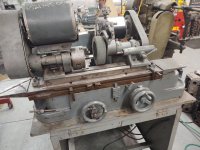PANTERA79
Aluminum
- Joined
- Feb 22, 2011
- Location
- south carolina
Hey guys, my problem, need to grind a 35" radius on the end face of a 7/8 diameter part. So far I have tried dressing the radius on the wheel, using my std. old Crystal Lake OD grinder. No luck.. wheel breaks down very fast. This is a production job, so I need a better method than a one-sey type fixture.. Here are my thoughts, and please correct me if I'm wrong. Thinking maybe I should try a universal type OD grinder, where the work head can be moved off center, (swivel) and use a cup wheel. But then I'm thinking that would generate a taper, not a true radius?? Than I thought maybe a tool grinder like a Yuasa GX, or similar, like to sharpen ball end mills, but the radius on those I know can't go that large.. Unless I'm missing something, don't know much about tool grinders.. Lastly, a 2-axis cnc cylindrical.. I know even less about these, but if it programs like a lathe with a G03, I could program a radius move? If both axis permit circular interpolation? But I would rather do on some sort of manual grinder if possible. Oh and no, actual automotive tappet grinders like a sunnen or old Tobin-arp leave horrendous finishes, and really don't grind a true spherical radius, already been down that road.. Lol. Thanks guys for any help offered!





